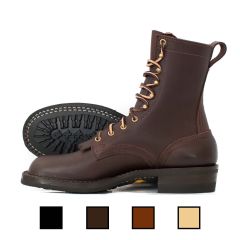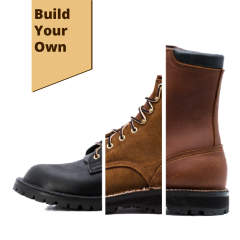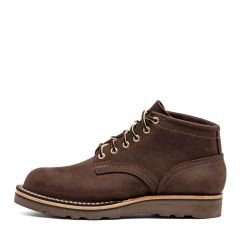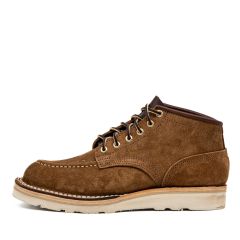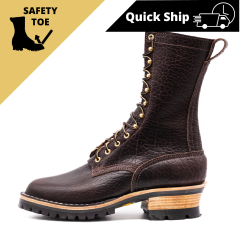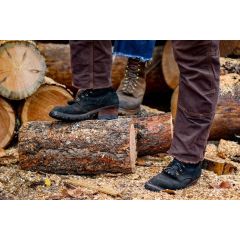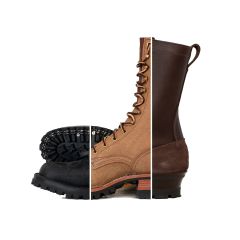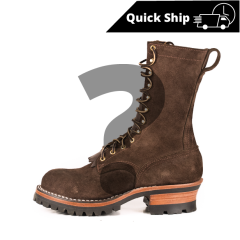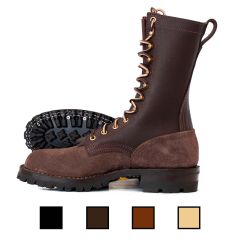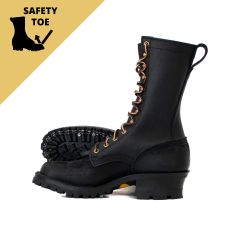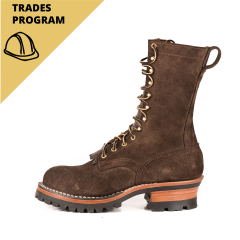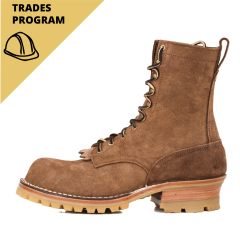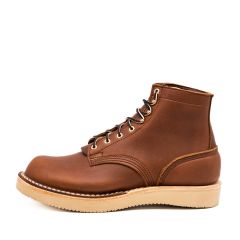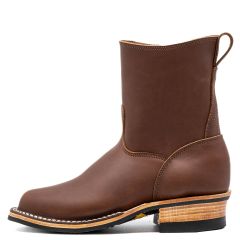Carpenter Boots
What Are Carpenter Boots?
Carpenter boots are a specific type of work boot designed to meet the physical demands of carpentry and other skilled trades. These boots provide durability, stability, and protection for professionals who spend long hours on their feet, often in environments with sharp tools, heavy materials, and unpredictable surfaces.
What sets carpenter boots apart is their balance between rugged construction and all-day comfort. They often feature reinforced stitching, supportive midsoles, and high-quality materials like full grain leather for long-lasting performance. Whether climbing ladders, kneeling on joists, or walking across uneven ground, a good pair of carpenter boots supports every step while standing up to daily wear and tear.
Why Quality Matters In Carpenter Boots
Quality isn’t just a bonus when it comes to carpenter boots—it’s essential. Carpentry work exposes boots to tough conditions: moisture, abrasion, heavy impact, and constant motion. A well-made boot doesn't just last longer; it also protects your feet, supports your posture, and helps prevent fatigue or injury over time.
High-quality carpenter boots are typically constructed from durable materials like full grain leather, known for its toughness and ability to conform to the foot over time. These boots also avoid synthetic fillers, relying instead on natural materials that breathe better and break in comfortably. Quality craftsmanship ensures secure stitching, reinforced soles, and proper structure—features that directly impact how the boots perform on the job.
Choosing quality might cost more upfront, but it often means fewer replacements and greater safety in the long run.
Key Features To Look For In Carpenter Boots
When choosing carpenter boots, there are a few essential features to consider to ensure you're getting both protection and performance on the job:
- Durable Uppers: Full grain leather uppers are ideal for long-term use. They resist punctures, conform to your foot over time, and offer excellent protection against rough jobsite conditions.
- Comfortable Support: Look for boots with cushioned insoles and solid arch support. Long hours on your feet require a boot that reduces strain on your legs and lower back.
- Reliable Outsoles: Rubber outsoles are a strong choice for carpenters. They offer traction, resist slipping, and handle both indoor and outdoor work surfaces well.
- Goodyear Welt Construction: This classic method of boot-making adds durability and allows for resoling, extending the life of your boots significantly.
- Lace-Up Design with Secure Fit: Adjustable laces help ensure a snug, stable fit—important when you're moving around ladders, scaffolds, or uneven terrain.
By prioritizing these features, you’re not just buying a pair of boots—you’re investing in better performance, comfort, and safety on the job.
Leather vs. Rubber Soles: Which Is Best?
When it comes to carpenter boots, the type of sole can make a big difference in how the boots perform in various work conditions. The two most common options are leather and rubber soles—each with its own strengths.
Leather soles offer a traditional, breathable option that molds to your foot over time. While they can be incredibly durable and comfortable once broken in, they’re better suited to dry, controlled environments. All-leather boots may take some time to soften up, but they’re known for their longevity and classic feel.
Rubber soles, on the other hand, are the more practical choice for most carpenters. They offer excellent traction, especially on wet or slippery surfaces, and are more forgiving on hard ground like concrete or pavement. Rubber also absorbs shock better, helping reduce fatigue over long workdays.
Why Nicks Boots Are A Top Choice For Carpenter Boots
Nicks Boots has earned a reputation for crafting high-quality work boots built to endure the toughest trades—including carpentry. Each pair is handmade in the USA with full grain leather and traditional techniques like Goodyear welt construction, ensuring not only durability but also the ability to be resoled and rebuilt over time.
What makes Nicks stand out is their focus on using premium materials without synthetic fillers. This results in boots that not only last longer but also conform to the wearer's feet for a more supportive, natural fit. For carpenters who spend long days on their feet, this means reduced fatigue and more comfort without sacrificing toughness.
Whether you’re framing houses, installing trim, or climbing ladders, Nicks Boots offers the kind of protection and performance that working professionals can trust day after day.
Top Carpenter Boots from Nicks Boots
If you’re looking for carpenter boots that combine strength, comfort, and long-term value, here are some of the top picks from Nicks Boots:
Aldert Strider
Built for versatility, the Aldert Strider offers a supportive fit and tough full grain leather ideal for both work and casual wear. It’s rugged enough for demanding tasks but styled to transition off the job site.
Strider Moc Toe – Classic Configuration
Featuring a classic moc toe and durable construction, this boot delivers comfort and flexibility for long hours on the move. It’s a great choice for carpenters looking for both style and structure.
Americana Heritage Boot
This boot blends traditional American craftsmanship with robust leather and a solid build, making it well-suited for heavy-duty work environments.
Bison BuilderPro – 55 Last (Classic Configuration)
With a unique bison leather upper and the 55 Last for an ergonomic fit, this boot offers maximum durability and foot support for all-day wear.
BuilderPro HD
Designed for professionals who demand more from their gear, the BuilderPro HD provides extra reinforcement and excellent ankle support, perfect for labor-intensive carpentry.
BuilderPro HD – Quick Ship
The same rugged design as the BuilderPro HD, available with faster delivery times. Ideal for when you need dependable boots without a long wait.
Arched Wedge
Offering excellent shock absorption and support, the Arched Wedge is ideal for carpenters who spend a lot of time on hard surfaces like concrete.
HardwearPro – Classic Configuration
Built for extreme durability, the HardwearPro includes reinforced components and sturdy construction, making it a powerhouse for demanding trades.
HotWork
Designed with fire-resistant properties, the HotWork is a specialty boot ideal for carpenters working in environments with sparks, heat, or welding exposure.
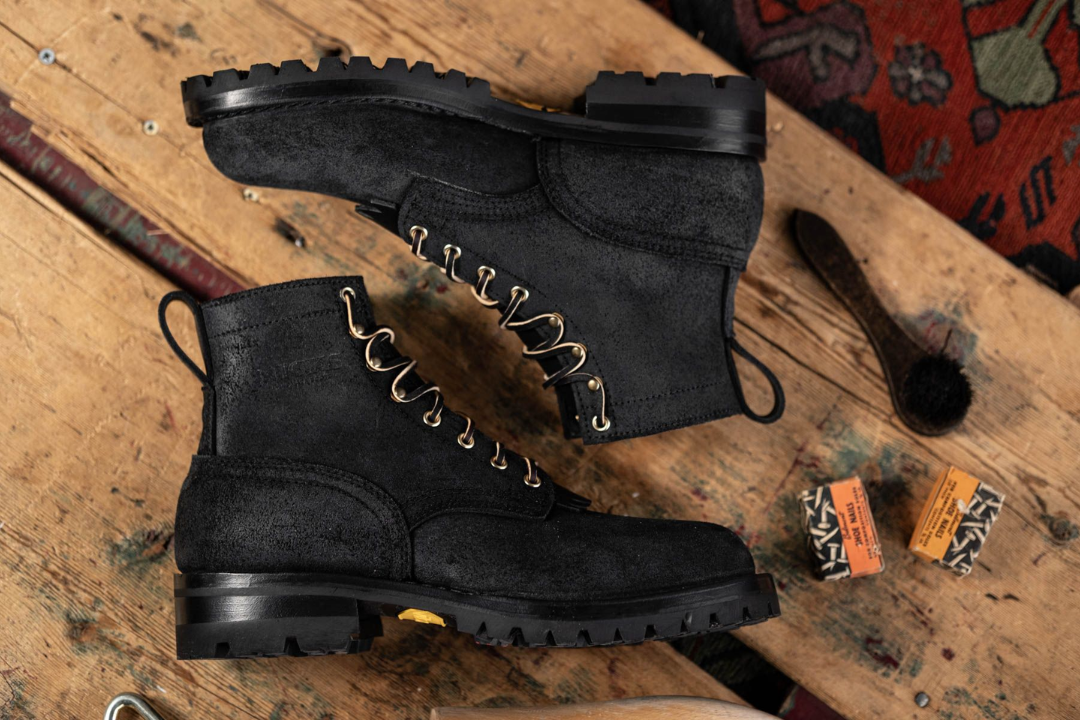
Howard Boot – Classic Configuration
A classic profile with a robust leather upper, the Howard Boot delivers traditional craftsmanship and everyday work performance.
Lineman
Originally built for utility line work, the Lineman offers excellent ankle support and grip, making it a solid choice for carpenters working at heights.
Marshal Duty Boot
Lightweight but tough, the Marshal Duty Boot brings tactical comfort and quick responsiveness, perfect for mobile carpenters or those on the go.
Read also:
- Nicks Boots vs. Thursday Boots
- Logger Boots: The Ultimate Guide To Quality And Durability
- How To Waterproof Leather Work Boots
Frequently Asked Questions About Carpenter Boots
What’s the difference between carpenter boots and construction boots?
Carpenter boots tend to prioritize flexibility and comfort for tasks that require precision and movement, like framing and finishing work. Construction boots often focus more on impact protection, such as steel toes and puncture-resistant soles.
Do carpenter boots need to be waterproof?
Not necessarily. Waterproofing is helpful if you work outdoors or in damp environments, but breathability can be more important for indoor carpentry. Many carpenters choose water-resistant leather and condition it regularly to maintain protection.
Can carpenter boots be worn casually?
Yes. Many carpenter boots, especially those made with premium leather and minimal branding, have a rugged look that works well for everyday casual wear. They often pair well with jeans or workwear-inspired fashion.
How long should a pair of carpenter boots last?
With proper care and occasional resoling, a high-quality pair—like those from Nicks Boots—can last several years or even decades. Longevity depends on usage, maintenance, and the boot’s construction.
Are steel toe boots necessary for carpenters?
Not always. While steel toe boots offer additional protection, many carpenters prefer soft toe boots for better mobility and lighter weight. It depends on the job site’s safety requirements and personal preference.
How do I break in new carpenter boots faster?
Wear them in short intervals at first, use leather conditioner to soften the upper, and pair them with thick socks. Gradual use helps avoid blisters while allowing the boot to mold to your foot.
What’s the ideal heel height for carpenter boots?
A moderate heel (typically around ¾ inch to 1 inch) offers good balance and arch support without affecting mobility. It also helps with stability on ladders and uneven ground.
Do carpenter boots need arch support?
Yes. Since carpenters often stand or kneel for hours, good arch support helps prevent fatigue and discomfort. Look for boots with a contoured footbed or orthotic compatibility.
Can I use carpenter boots for hiking or outdoor activities?
Some carpenter boots, especially those with rugged soles and ankle support, can double as outdoor boots. However, they’re not a direct replacement for specialized hiking boots designed for steep or rocky terrain.
How do I maintain the leather on carpenter boots?
Clean your boots regularly, apply a leather conditioner every few weeks, and store them in a cool, dry place. Avoid soaking them in water and let them air dry naturally if they get wet.
